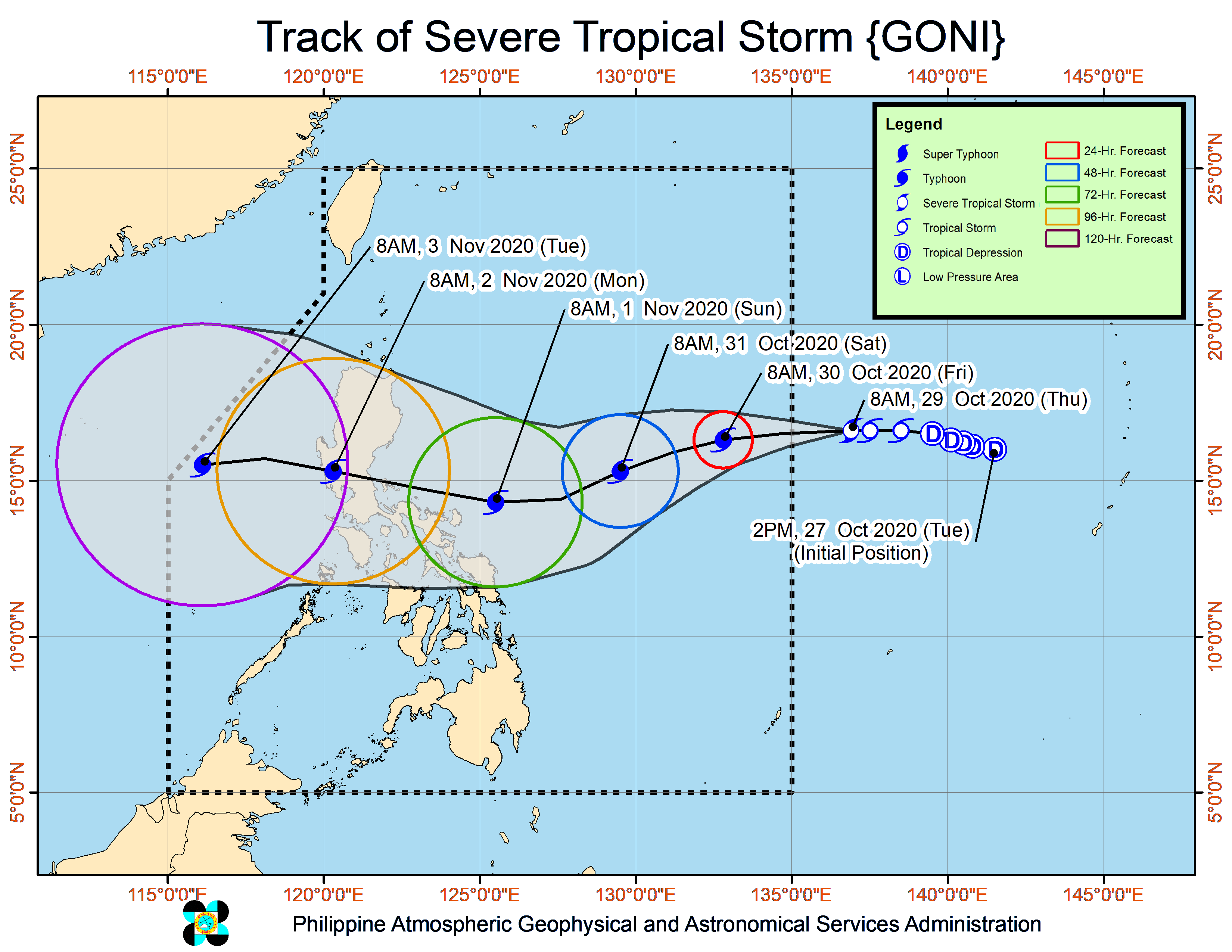
Weather forecasters on Thursday said a severe tropical storm that could develop into a typhoon was moving toward Luzon and was expected to drench large parts of the country’s main island, including Metro Manila, over the All Saints’ Day weekend.
The Philippine Atmospheric, Geophysical and Astronomical Services Administration (Pagasa) said that by Friday, an extension of rain clouds from Severe Tropical Storm “Rolly” (international name: Goni), would bring scattered rain and thunderstorms over Eastern Visayas and northeastern Mindanao.
It said the storm, which was still more than 1,000 kilometers east of the country on Thursday afternoon, would continue to intensify to typhoon strength by Friday as it blows westward across the Philippine Sea.
Rolly was seen to make landfall on Saturday or Sunday in Quezon and Aurora provinces, with the Bicol region avoiding a direct hit, Pagasa said.Tropical cyclone wind signal No. 1 may still be hoisted over several provinces in Bicol and Northern Samar by Friday evening.
An earlier forecast showed the storm following the track of the destructive Typhoon “Quinta” (international name: Molave), which left 16 people dead after lashing southern Luzon last weekend.
Despite a slight difference in Rolly’s track, Pagasa still warned residents in the eastern portions of Central and southern Luzon to prepare for heavy rains this weekend.
As of 3 p.m. on Thursday, the storm was located at 1,505 kilometers east of Central Luzon, packing maximum winds of 110 km per hour and gusts of up to 135 kph. It was moving westward at 15 kph.
Bicol ‘red alert’
In Legazpi City, the regional Office of Civil Defense (OCD) on Thursday directed all local disaster councils across Bicol to stay on “red alert” and to start preemptive evacuation in places prone to floods, lahars, landslides and storm surges once heavy rains and winds begin to lash these areas.
Mass evacuations
The directive came barely a week after 69,187 families, or 261,422 people, were evacuated some 24 hours before Quinta hit the region.
Quinta swept through southern Luzon on Monday and Tuesday this week, leaving 13 people dead, damaging hundreds of homes and causing losses of nearly P2 billion in agriculture and infrastructure in the provinces of Albay, Camarines Sur, Camarines Norte, Sorsogon, Catanduanes and Masbate provinces in Bicol; Mindoro Oriental, Marinduque, Romblon and Palawan in Mimaropa; and Cavite, Laguna, Batangas, Rizal and Quezon in Calabarzon.
‘No sailing’ policy
Claudio Yucot, the OCD Bicol chief, directed the local disaster councils to strictly enforce the “no sailing” policy for fishermen, said Gremil Alexis Naz, the agency’s spokesperson.
The measure would prevent a repeat of an incident that left eight people dead, six of them fishermen from Bicol, who ignored the storm warning. Two other fishermen remained missing as of Thursday.
Dr. Paul Karson Alanis, resident volcanologist of the Philippine Institute of Volcanology and Seismology (Phivolcs) in Legazpi, advised Albay residents to stay vigilant for possible lahar flows in case of torrential rains.
When Quinta hit Albay last Sunday, close to 2,000 families living on the slopes of Mayon were evacuated.
Several roads in one town became impassable due to debris that cascaded down the slopes of the volcano.
Stranded passengers
The provincial government of Oriental Mindoro, one of the hardest hit by Quinta, on Thursday suspended the entry of stranded people returning to the province to give officials enough time to deal with the devastation caused by the typhoon and prepare for another storm.
14-day ban
The province was placed under a state of calamity due to heavy typhoon damage to farms and infrastructure.
Gov. Humerlito Dolor clarified that the 14-day ban, which would remain until Nov. 11, should not be a problem for residents or tourists who had tested negative for the new coronavirus that causes COVID-19.
“They will still be allowed entry [during the period],” Dolor said.
A person may travel to Oriental Mindoro, about two hours by ferry from Batangas City, within 24 hours from the time his test result is released.
Quarantine centers
Dolor said they were trying to prevent overcrowding at COVID-19 quarantine centers that in many villages were also being used as evacuation centers during typhoons.
He said local government personnel were overwhelmed with the relief distribution for the more than 16,000 people affected by the recent typhoon.
Residents with relatives scheduled to return home for All Saints’ Day criticized the ban, but Dolor said it was a necessary precaution against a virus surge, especially after the province’s daily average of new infections had been reduced to “1 to 2.”
Oriental Mindoro had 64 active cases, out of 144 in the whole region, as of Oct. 27, according to the Department of Health.
Dolor also said more than 30,000 people had returned to the province since May when local governments started bringing home residents caught in lockdowns in Metro Manila and other provinces.
“We have to balance things here,” he said.
Angat water level up
In what may be good news, especially for Metro Manila, the National Irrigation Administration (NIA) on Thursday reported that the water level at Angat Dam in Bulacan province had risen to more than 20 meters following three storms this month.
Rains from Tropical Depression “Ofel” on Oct. 14 raised the dam’s water level by 4.3 meters above sea level (masl) from 179.67 meters just three days earlier.
It rose to 190.37 masl with rains from Typhoon “Pepito” on Oct. 21. Quinta had elevated it to 200.20 masl by Thursday, close to its 212-masl spilling mark.
The dam will need about nine more meters to ensure sufficient and uninterrupted water supply to Metro Manila, especially by the first quarter of 2021, according to Francis Clara, head of NIA water control coordination unit.
Bustos and Ipo dams, which catch runoff rainwater from Angat Dam, continued to discharge water after their elevation remained above the spilling level. —WITH REPORTS FROM MAR S. ARGUELLES, MICHAEL JAUCIAN, MARICAR CINCO AND CARMELA REYES-ESTROPE